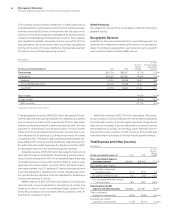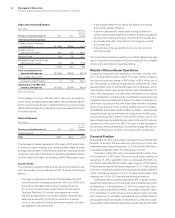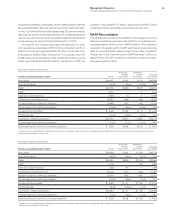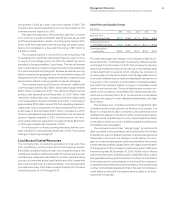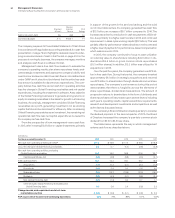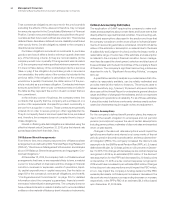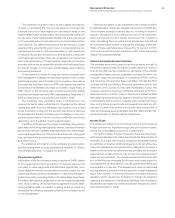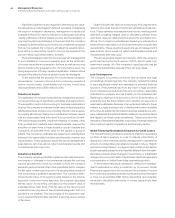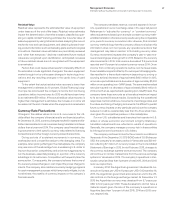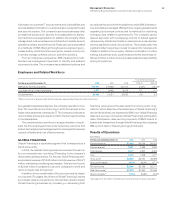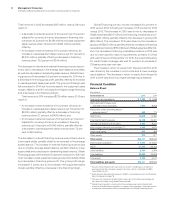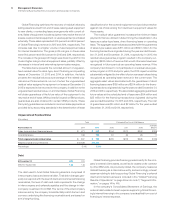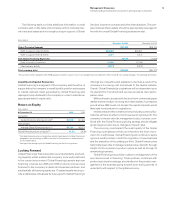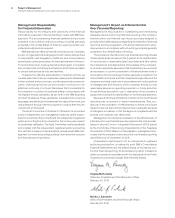IBM 2015 Annual Report Download - page 66
Download and view the complete annual report
Please find page 66 of the 2015 IBM annual report below. You can navigate through the pages in the report by either clicking on the pages listed below, or by using the keyword search tool below to find specific information within the annual report.64 Management Discussion
International Business Machines Corporation and Subsidiary Companies
Total contractual obligations are reported in the previous table
excluding the effects of time value and, therefore, may not equal
the amounts reported in the Consolidated Statement of Financial
Position. Certain noncurrent liabilities are excluded from the previ-
ous table as their future cash outflows are uncertain. This includes
deferred taxes, derivatives, deferred income, disability benefits and
other sundry items. Certain obligations related to the company’s
divestitures are included.
Purchase obligations include all commitments to purchase
goods or services of either a fixed or minimum quantity that meet
any of the following criteria: (1) they are noncancelable, (2) the
company would incur a penalty if the agreement was canceled,
or (3) the company must make specified minimum payments even
if it does not take delivery of the contracted products or services
(take-or-pay). If the obligation to purchase goods or services is
noncancelable, the entire value of the contract is included in the
previous table. If the obligation is cancelable, but the company
would incur a penalty if canceled, the dollar amount of the pen-
alty is included as a purchase obligation. Contracted minimum
amounts specified in take-or-pay contracts are also included in
the table as they represent the portion of each contract that is a
firm commitment.
In the ordinary course of business, the company enters into
contracts that specify that the company will purchase all or a
portion of its requirements of a specific product, commodity or
service from a supplier or vendor. These contracts are generally
entered into in order to secure pricing or other negotiated terms.
They do not specify fixed or minimum quantities to be purchased
and, therefore, the company does not consider them to be pur-
chase obligations.
Interest on floating-rate debt obligations is calculated using the
effective interest rate at December31, 2015, plus the interest rate
spread associated with that debt, if any.
Off-Balance Sheet Arrangements
From time to time, the company may enter into off-balance sheet
arrangements as defined by SEC Financial Reporting Release 67
(FRR-67), “Disclosure in Management’s Discussion and Analysis
about Off-Balance Sheet Arrangements and Aggregate Con-
tractual Obligations.”
At December31, 2015, the company had no off-balance sheet
arrangements that have, or are reasonably likely to have, a material
current or future effect on financial condition, changes in financial
condition, revenues or expenses, results of operations, liquid-
ity, capital expenditures or capital resources. See the table on
page63 for the company’s contractual obligations, and noteM,
“Contingencies and Commitments,” on page120, for detailed
information about the company’s guarantees, financial commit-
ments and indemnification arrangements. The company does not
have retained interests in assets transferred to unconsolidated
entities or other material off-balance sheet interests or instruments.
Critical Accounting Estimates
The application of GAAP requires the company to make esti-
mates and assumptions about certain items and future events that
directly affect its reported financial condition. The accounting esti-
mates and assumptions discussed in this section are those that
the company considers to be the most critical to its financial state-
ments. An accounting estimate is considered critical if both (a) the
nature of the estimate or assumption is material due to the levels
of subjectivity and judgment involved, and (b) the impact within a
reasonable range of outcomes of the estimate and assumption
is material to the company’s financial condition. Senior manage-
ment has discussed the development, selection and disclosure of
these estimates with the Audit Committee of the company’s Board
of Directors. The company’s significant accounting policies are
described in noteA, “Significant Accounting Policies,” on pages
82 to 92.
A quantitative sensitivity analysis is provided where that infor-
mation is reasonably available, can be reliably estimated and
provides material information to investors. The amounts used to
assess sensitivity (e.g., 1percent, 10percent, etc.) are included to
allow users of the Annual Report to understand a general direction
cause and effect of changes in the estimates and do not represent
management’s predictions of variability. For all of these estimates,
it should be noted that future events rarely develop exactly as fore-
casted, and estimates require regular review and adjustment.
Pension Assumptions
For the company’s defined benefit pension plans, the measure-
ment of the benefit obligation to employees and net periodic
pension (income)/cost requires the use of certain assumptions,
including, among others, estimates of discount rates and expected
return on plan assets.
Changes in the discount rate assumptions would impact the
(gain)/loss amortization and interest cost components of the net
periodic pension (income)/cost calculation and the projected ben-
efit obligation (PBO). The company increased the discount rate
assumption for the IBM Personal Pension Plan (PPP), a U.S.-based
defined benefit plan, by 30 basispoints to 4.00percent on Decem-
ber31, 2015. This change will decrease pre-tax cost and expense
recognized in 2016 by an estimated $100million. If the discount
rate assumption for the PPP had decreased by 30 basispoints
on December31, 2015, pre-tax cost and expense recognized in
2016 would have increased by an estimated $98million. Changes
in the discount rate assumptions would impact the PBO which,
in turn, may impact the company’s funding decisions if the PBO
exceeds plan assets. A 25 basis point increase or decrease in the
discount rate would cause a corresponding decrease or increase,
respectively, in the PPP’s PBO of an estimated $1.3billion based
upon December31, 2015 data.




